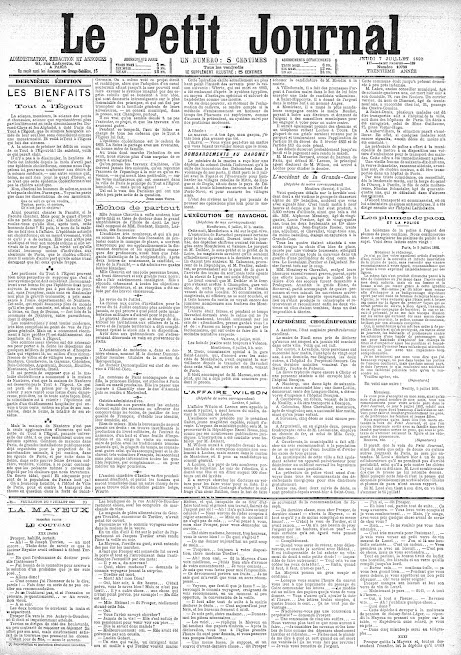
BULL-FIGHTING.Opening of the Season in the Corrida of the Rue
Pergolèse.
Once again the Corrida, or the bull-fighting arena, in
the rue Pergolèse has opened its doors, and yesterday afternoon at two o´clock the
first bull-fights of the season took place.
Bibliothèque nationale de France
The first part of the performance was a failure and
brought down nothing but wrath and derision upon the heads of the management.
It had been announced that the bulls were from the famous breeding establishment
of the Duc de Veragua, in Andalusia. His breed of bulls is not to be mistaken for
any other. The bulls are of dark chestnut brown, perfect in shape, with low,
long strong bodies, slender limbs, and as full of fire as a volcano. The first
four bulls which we were shown yesterday has probably never seen the breeding
establishment of the famous Duke. Someone said they were of the Landais breed,
and that soeone was very nearly right.
THE BULL-FIGHTERS.
There were two sets of bull-fighters introduced. The first
were Spanish, with Angel Pastor as matador, and his following, José Bento de Araujo
as the caballero en plaza, and Mlle. Maria Gentis as caballera en plaza.
The second was a French set, under the guidance of
Etienne Pouly. They were the novelties of the afternoon, and certainly gave us
a performance which was wonderful, strange and unusual to those accustomed to
bull-fighting conducted on the orthodox Spanish lines. They are, in fact, more
acrobats than bull-fighters. One of their favorite exhibitions is to wait for
the bull to rush at them, and then, just as he reaches them, turn a somersault
over him, or jump over his back.
A Spaniard next to me said that that might be all
right with the slow Landais bulls, but it would surely fail with a quick,
thoroughbred, fighting Spanish animal. Perhaps he was right; but, in any case,
the feat looked dangerous enough, and its performance called forth great
applause from the French section of the audience. The Spanish portion, which,
by the way, was very large, looked upon this style of show rather coldly.
THE SPANIARDS.
As regards the Spanish fighters, the triumph of the
afternoon fell to the caballero en plaza for his fine display of horsermanship,
which fairly took the house by storm. The magnificent purebred Spanish gray
horse he rode to perfection is a perfect picture of equine refinement. His
performance when he placed the banderillas in the most lively bull of the
afternoon, seeming to place them at will, brought forth round after round of
enthusiastic applause. The effect was certainly most picturesque as this fine
horseman, in a magnificent coat of emerald silk velvet, with his cavalier top
boots and three-cornered hat, sitting like a statue on his beautiful horse,
manoeuvred round and round the irate bull, that vainly tried to toss them both.
When it was all over and the domed roof was sending
back the echoes of the applause of the audience, a pretty little bit of
sideplay was going on which but few saw. As soon (José Bento de) Araujo had
passed outside the arena he dismounted, and his first action was not to return
and thank the audience that had so liberally applauded him, but his thought was
his horse. He clasped it affectionately around the neck, and with great energy
kissed it on the nose and again on the neck. Then he once more entered the
hall.
THE PICADORS.
Next to the caballero en plaza, the honors among the
Spanish fighters to the picadors, who showed some fine work with their spears,
and most effectually baffled the attemps of the strongest bull of the afternoon
to throw them over.
As usual the pole-jumper received a large share of the
applause, and there were loud cries for the chair feat with the banderillo,
which was effectively executed.
During the interval between the two parts of the
performance I paid a visit to the corral where the bulls are kept, and noticed
the fact that the bulls which had served in the previous fights were still
there, with the banderillas and hooks still sticking in their flesh. Surely
this cruelty should not be allowed. It was a sickening sight. How long the poor
brutes are allowed to remain in this condition I cannot say, but I do know that
the first one had been thus standing in the hot sun for an hour.
In THE NEW YORK HERALD, Paris – 27 de Junho de 1892










.jpg)


.jpg)


















